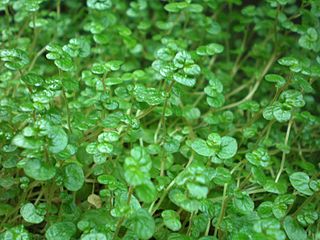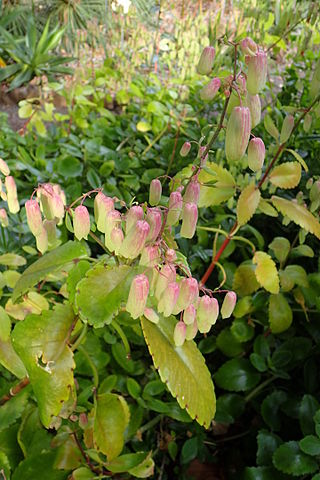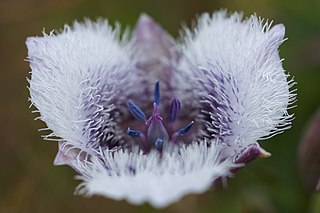See also
- Mother of millions, Kalanchoe delagoensis , formerly Bryophyllum delagoense
Mother of thousands is a common name for several plants, including:

The Crassulaceae, also known as the stonecrop family or the orpine family, are a diverse family of dicotyledon flowering plants characterized by succulent leaves and a unique form of photosynthesis, known as Crassulacean acid metabolism (CAM). Flowers generally have five floral parts. Crassulaceae are usually herbaceous but there are some subshrubs, and relatively few treelike or aquatic plants. Crassulaceae are a medium-sized monophyletic family in the core eudicots, among the order Saxifragales, whose diversity has made infrafamilial classification very difficult. The family includes approximately 1,400 species and 34–35 genera, depending on the circumscription of the genus Sedum, and distributed over three subfamilies. Members of the Crassulaceae are found worldwide, but mostly in the Northern Hemisphere and southern Africa, typically in dry and/or cold areas where water may be scarce, although a few are aquatic.

Kalanchoe, also written Kalanchöe or Kalanchoë, is a genus of about 125 species of tropical, succulent plants in the stonecrop family Crassulaceae, mainly native to Madagascar and tropical Africa. A Kalanchoe species was one of the first plants to be sent into space, sent on a resupply to the Soviet Salyut 1 space station in 1979. The majority of kalanchoes require around 6–8 hours of sunlight a day; a few cannot tolerate this, and survive with bright, indirect sunlight to bright shade.
A Mexican hat is a sombrero – a broad-brimmed and high-crowned hat.

Soleirolia soleirolii is a flowering plant in the nettle family. It has a number of common names, including baby's tears, angel's tears, peace in the home, bits and pieces, bread and cheese, Corsican creeper, Corsican curse, friendship plant, mind-your-own-business, pollyanna vine, Paddy's wig, and mother of thousands. It should not be confused with Kalanchoe daigremontiana, another plant known as mother of thousands.

Bryophyllum is a group of plant species of the family Crassulaceae native to Madagascar. It is a section or subgenus within the genus Kalanchoe, and was formerly placed at the level of genus. This section is notable for vegetatively growing small plantlets on the fringes of the leaves; these eventually drop off and root. These plantlets arise from mitosis of meristematic-type tissue in notches in the leaves.

Kalanchoe daigremontiana, formerly known as Bryophyllum daigremontianum and commonly called mother of thousands, or Mexican hat plant, is a succulent plant native to Madagascar. Like other members of Bryophyllum, it can propagate vegetatively from plantlets that develop on its leaf margins, as well as through upshoots from lateral roots, and seeds. All parts of this species contain a very toxic steroid known as daigremontianin.

Kalanchoe thyrsiflora is a species of flowering plant native to Botswana, Lesotho, South Africa and Eswatini. This plant is rare in cultivation, and those plants labelled as "Kalanchoe thyrsiflora" in horticulture are mostly another similar species, Kalanchoe luciae.
Paddle plant or flapjacks may refer to:
A White Lady is a type of female ghost, typically dressed in a white dress or similar garment.
Chocolate Soldier is an expression referring to a good-looking but useless warrior, popularised by George Bernard Shaw's 1894 play Arms and the Man. The term originates as a derogatory label for a soldier who would not fight but would look good in a uniform, shortened from 'Chocolate Cream Soldier'.
"Do you agree, Mr. Clay," she asked, "or do you prefer the chocolate-cream soldiers, in red coats and gold lace?"
(from: Soldier of Fortune by Richard Harding Davis. 1897)

Kalanchoe blossfeldiana is a commonly cultivated evergreen house plant of the genus Kalanchoe native to Madagascar. It is known by the English common names flaming Katy, Christmas kalanchoe, florist kalanchoe and Madagascar widow's-thrill.

Kalanchoe delagoensis, formerly known as Bryophyllum delagoense and commonly called mother of millions or chandelier plant, is a succulent plant native to Madagascar. Like other members of Bryophyllum, it is able to propagate vegetatively from plantlets that develop on its leaf margins.

Kalanchoe pinnata, commonly known as cathedral bells, air plant, life plant, miracle leaf, Goethe plant, and love bush, is a succulent plant native to Madagascar. It is a popular houseplant and has become naturalized in tropical and subtropical areas. The species is distinctive for the profusion of miniature plantlets that form on the margins of its leaves, a trait it has in common with some other members of Bryophyllum.

Pussy ears is a common name for several plants and may refer to:
Flapjack may refer to:
Penwiper is a common name that can refer to a number of plant species in different nations.
K. floribunda may refer to:

Kalanchoe beauverdii is a species of flowering plant in the family Crassulaceae. It goes by the common name Beauverd's widow's-thrill.